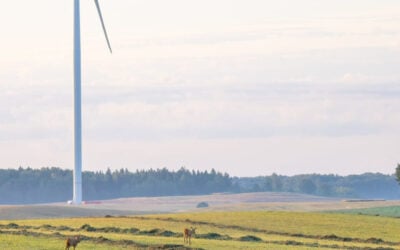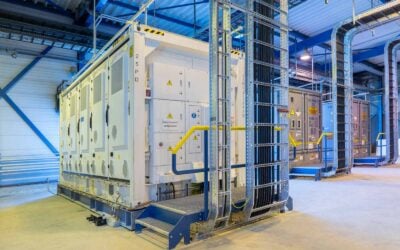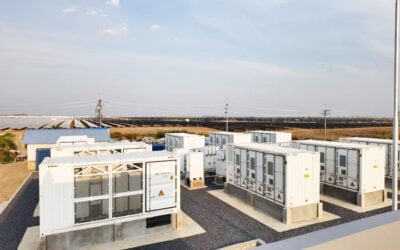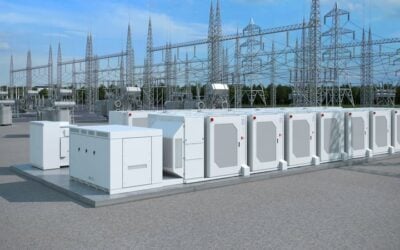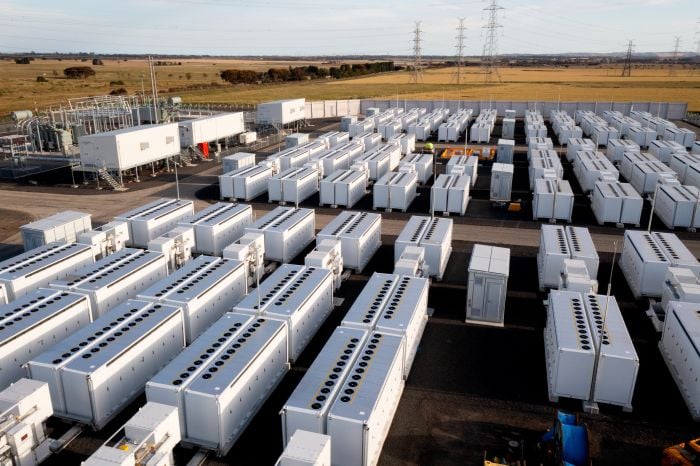
The inverters at an upcoming 300MW/600MWh battery energy storage system (BESS) project in Scotland, UK, will enable the asset to deliver inertia that is “essential for the grid to function efficiently”.
Referring to the company’s latest contract award from repeat customer Zenobe Energy, Andy Tang, head of Wärtsilä Energy Storage & Optimisation (ES&O), told Energy-Storage.news Premium that the South Kilmarnock BESS will provide stability services including “true synthetic inertia” and Short-Circuit Level system voltage management.
Enjoy 12 months of exclusive analysis
- Regular insight and analysis of the industry’s biggest developments
- In-depth interviews with the industry’s leading figures
- Annual digital subscription to the PV Tech Power journal
- Discounts on Solar Media’s portfolio of events, in-person and virtual
As mentioned in Energy-Storage.news coverage of the project last week, the project’s main applications include enabling the growth of renewables in the region and reducing curtailment of resources, particularly offshore wind, which provides the bulk of the UK’s renewable generation.
However, South Kilmarnock has also been selected as one of the Stability Pathfinder projects supported by the electricity system operator National Grid ESO. The ESO manages the real-time flow of electricity on the grid, including wholesale and grid services markets, as opposed to the operation of the transmission system, which is done by National Grid TSO.
‘Pushing technical boundaries of support types batteries can provide’
While the proportion of energy generation from fossil fuels on the grid is going down and the proportion from renewables going up, there are also numerous other applications traditionally provided by fossils (and other thermal generation like nuclear) that need to be replaced.
Those include the main ancillary services like frequency regulation, which battery storage is adept at providing due to its millisecond response times and ability to deliver bursts of power to correct supply-demand mismatches that can cause the grid’s operating frequency to deviate.
That has been extremely well documented and is more often than not the first application BESS assets are built to provide, as seen in the UK with its 2016 enhanced frequency response (EFR) tender, the PJM market in the US, or in Germany’s early BESS boom.
However, the role thermal generation plants have traditionally played in contributing stability services, most prominently inertia, is trickier to replace.
Inertia comes from the motion of turbines in thermal generation. The rotating mass of those synchronous machines can, however, be mimicked by the operation of advanced inverters.
“The inertia will be provided through the inverters,” Andy Tang said of the project in Scotland.
“The battery system will provide stability services to the National Grid ESO including short-circuit level and true synthetic inertia, which are essential for the grid to function efficiently as fossil fuel plants phase out.”
Tang said that the project will couple Wärtsilä’s new BESS solution, GridSolv Quantum High Energy (HE), with inverter technology. He said the combination is “an innovative solution that pushes the technical boundaries of the types of support that batteries can provide to the grid”, with the company’s GEMS Digital Energy platform energy management system (EMS), controlling the energy storage system.
The software-driven platform will also “leverage historic and real-time data analytics to optimise operations, while easing network constraints by importing electricity at times of peak renewable generation,” enabling customer Zenobe to put the batteries’ stored energy into the most valuable energy market opportunities available.
Often described as a grid-forming capability, this provision of inertia could be done from any inverter-based energy technology.
Grid-forming battery storage assets have been prominent in Australia recently, with the country’s official renewables agency, ARENA, supporting at least 4.2GWh of projects with direct financial assistance for adding advanced inverters – at both new-build and retrofitted sites.
ARENA last April also supported the implementation of ‘first-of-a-kind’ grid inertia measurement tools provided by Finland’s Reactive Technologies at the 300MW/450MWh Victorian Big Battery (VBB).
There are other technologies that can provide inertia to the grid, such as synchronous condensers. These are basically large rotating machines that don’t have a shaft attached to any equipment to drive it.
Synchronous condenser projects have also been supported by National Grid ESO’s pathfinder programme. A project in Ireland that recently broke ground includes a hybrid pairing of a 170MWh BESS and synchronous condenser technologies.
At this week’s Energy Storage Summit EU, hosted in London, UK, by our publisher Solar Media, Energy-Storage.news heard from the chief operating officer (COO) of a long-duration energy storage (LDES) startup that inertia could also be provided by its proprietary technology.
Ben Potter of Energy Dome, designer, and maker of the novel CO2 Battery as well as developer of projects that use the technology, said that while the thermomechanical battery is not a source of greenhouse gas (GHG) emissions – the CO2 stays in the domed bubble from which the company gets its name – it does drive turbines to generate electricity.
You can read more about the technology and the principles behind its development here, but in short, Potter said, the CO2 Battery doesn’t have to create inertia synthetically as with advanced inverters and is not a single-application solution like synchronous condensers.
“We do provide natural inertia because of the rotating masses, which is incredibly valuable for the grid and will increasingly be compensated going forward,” Potter said in a full interview to be published on the site soon.
Energy Dome’s technology is now commercial and in the scale-up phase, with the first large-scale iteration in construction in Sardinia, Italy, building off a commercial demonstrator that has been in operation for two years in the same region.
It seems likely that BESS with advanced inverters or synchronous condensers will be the market’s go-to replacement for spinning mass for the time being if South Kilmarnock and other early projects can prove the case for them, but it will be interesting to see if Energy Dome’s technology, or other new energy storage tech, can also play a part.

